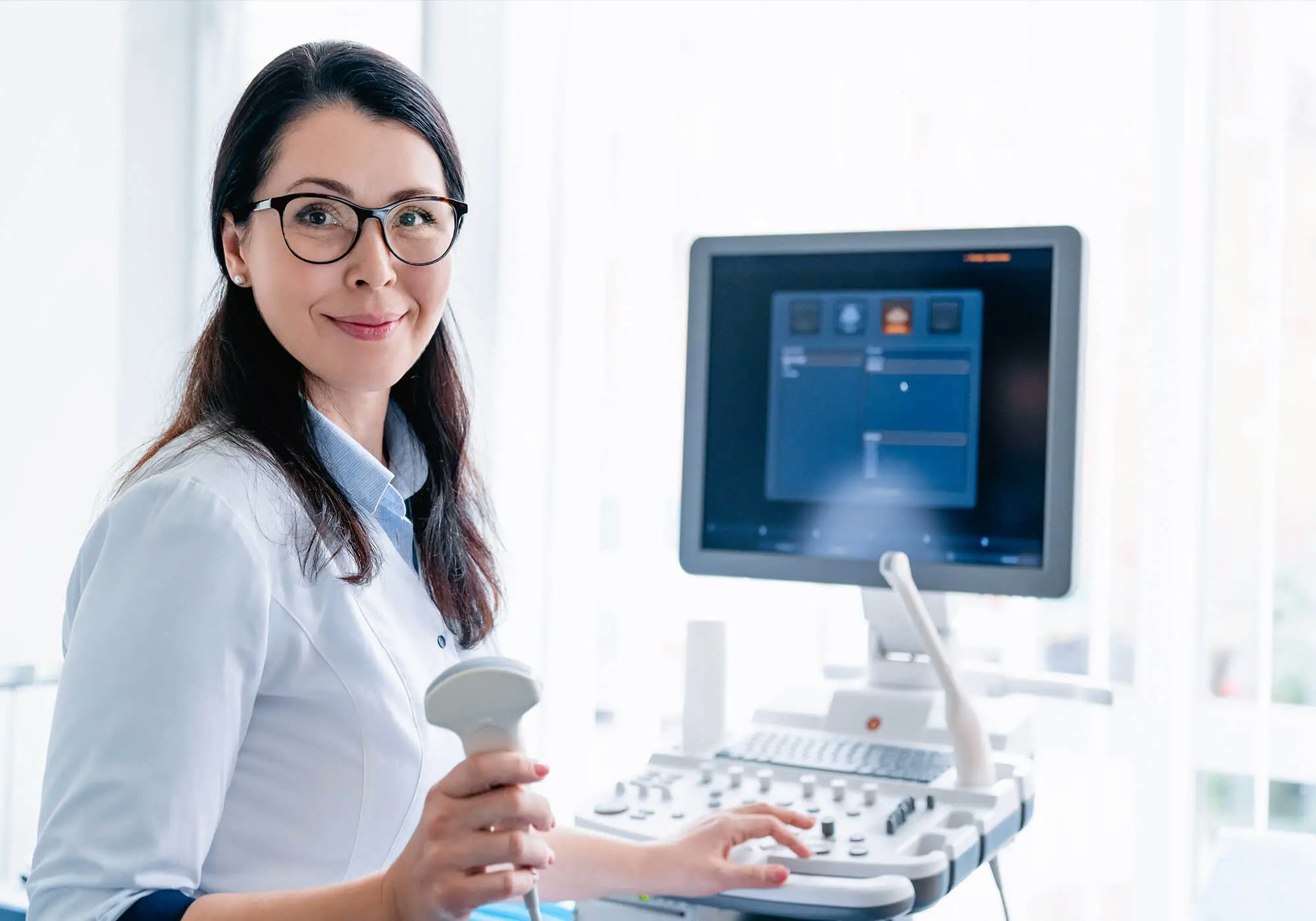How Ultrasounds are Detecting Cancer

July 22, 2024 | Charmaine Skoubo
Ultrasounds are becoming a key tool in early cancer detection
There is no denying firefighters face a higher chance of developing illnesses such as heart disease, cancer, and chronic respiratory disease. To identify these issues early on, the use of ultrasounds has become key in recent years while offering a safe, cheap, and non-invasive method of assisting firefighters in early cancer and heart disease detection.
Diagnostic ultrasound, also called sonography or diagnostic medical sonography, is an imaging method that uses sound waves to produce images of structures within your body. The images can provide valuable information for diagnosing and directing treatment for a variety of diseases and conditions.
Most ultrasound examinations are done using an ultrasound device outside your body, though some involve placing a small device inside your body. Diagnostic ultrasound is a safe procedure that uses low-power sound waves.
During an ultrasound, gel is applied to your skin over the area being examined. It helps prevent air pockets, which can block the sound waves that create the images. This safe, water-based gel is easy to remove from skin and, if needed, clothing. A typical ultrasound exam takes from 30 minutes to an hour.
Ultrasounds are used to diagnose and evaluate various diseases and bodily functions, including: Diagnose gallbladder disease, evaluate blood flow, guide a needle for biopsy or tumor treatment, examine a breast lump, check the thyroid gland, find genital and prostate problems, assess joint inflammation (synovitis), and evaluate metabolic bone disease. Ultrasound can reveal details that X-rays can’t, such as the presence of fluid-filled cysts.
Benefits of Ultrasounds
One of the significant benefits of ultrasound in cancer detection is its ability to detect abnormalities in the body at an early stage. When it comes to cancer, early tumor detection is critical to long-term survival. Cancerous tissues tend to have a different texture and density than healthy tissues. Ultrasounds can detect these differences, making it an essential diagnostic tool in the early detection and diagnosis of cancer.
Most cancer and heart disease starts with inflammation. Emerging science indicates that ultrasound has the ability to identify inflammation early in blood vessels, long before a plaque forms. Additionally, ultrasound is not invasive and does not expose patients to harmful radiation, making it a safer option than other imaging techniques such as CT scans or X-rays.
Consider a Florida fire chief’s case, when an ultrasound revealed a small nodule on her thyroid gland. She was told it was most likely benign and left the office. After a month of pondering, she returned and advocated for a biopsy, which ultimately revealed a small cancer, caught early and removed.
The leading cause of on-duty death for firefighters are caused by myocardial infarctions. With firefighters having easier access to ultrasounds for the heart, it can help identify issues in the heart before a possibly catastrophic event happens.
Types of Ultrasound Screenings
Organizations such as NDS Wellness give firefighters access to quick screenings for any problems that could impact their health and provide results and guidance for follow up care as medically indicated.
NDS Wellness offers ultrasound screenings which include Abdominal Aorta Screening (AAA), Echocardiograms, Thyroid and Carotid Ultrasounds, and Complete Abdominal Ultrasounds. NDS Wellness offers a range of services that can be customized to fit individual department’s needs, and their goal is to provide the most comprehensive care possible, focusing on prevention and early detection of potential health issues.
NDS Wellness offers two packages, or they can customize one to fit the needs of the individual. Package one is for cardiovascular screenings, including Echocardiogram, Carotid Doppler, and AAA. Package two is for comprehensive screenings, which includes Echocardiogram, Carotid Doppler, AAA, Thyroid, Complete Abdomen, and Testicular (males) or Pelvic (external – females).
What exactly do all these screenings mean? Let’s break down the ultrasounds to learn more:
- Echocardiogram: An ultrasound of the heart. This common test can show blood flow through the heart and heart valves. Your health care provider can use the pictures from the test to find heart disease and other heart conditions. There are different types of echocardiograms. The type you have depends on the reason for the test and your overall health. Some types of echocardiograms be done during exercise or pregnancy.
- Carotid Doppler: A carotid ultrasound uses sound waves to examine the blood flow and wall thickness of the carotid arteries in the neck. It can help diagnose and treat narrowed carotid arteries, which can increase the risk of stroke.
- AAA: An abdominal ultrasound uses sound waves to see inside the belly area and diagnose or rule out many health conditions. It’s the preferred screening test for an abdominal aortic aneurysm, a serious enlargement of the main artery in the lower body.
- Thyroid: A thyroid ultrasound is a non-invasive procedure that employs sound waves to create detailed images of the thyroid gland. This painless test can help diagnose various thyroid conditions, including benign nodules and potential thyroid cancers.
- Complete Abdomen: An abdominal ultrasound is a noninvasive procedure used to assess the organs and structures within the abdomen. This includes the liver, gallbladder, pancreas, bile ducts, spleen, and abdominal aorta.
- Testicular: A testicular ultrasound uses high-frequency sound waves to produce images of your testicles and the tissue around them. Images from the test will help them detect patterns that might indicate cancer. They can also reveal whether you have a cyst (fluid-filled sac), tumor or torsion.
- Pelvic: A pelvic ultrasound is a noninvasive diagnostic exam that produces images that are used to assess organs and structures within the female pelvis. A pelvic ultrasound allows quick visualization of the female pelvic organs and structures including the uterus, cervix, vagina, fallopian tubes and ovaries. Pelvic ultrasounds can provide much information about the size, location, and structure of pelvic masses, but cannot provide a definite diagnosis of cancer or specific disease.
As cancer remains a leading cause of death worldwide, early detection is critical in improving outcomes and survival rates. Medical professionals are continuously exploring new and innovative approaches to detect cancer, and ultrasounds have emerged as a promising technology in this field.
Colorado Firefighter Trust and the CSD Pool
The Colorado Firefighter Heart, Cancer, & Behavioral Health Benefits Trust was created to help the state’s fire professionals and agencies manage the human and financial burdens created by serious health issues by providing mandated cardiac and voluntary cancer benefits to the state’s firefighters. In February 2023, the Trust expanded to include behavioral health support.
The heart program is mandated by statute for full-time firefighters. The Colorado Department of Local Affairs reimburses 100% of this cost for full-time firefighters.
For the cancer program, if your department is a member of the CSD Pool Workers’ Compensation Program, you are only responsible for a small portion of contribution as the Pool continues to cover most of the cancer program contributions on behalf of its members.
With ultrasounds now being offered NDS Wellness, there’s no better time to join the Trust and make sure your health comes first. For more information, visit cfhtrust.com. To stay up to date on the latest Health news, check out our other health related articles.

